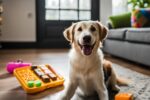Training Your Dog to Interact Safely with Children

Dogs and children can form a great bond, but it’s important to ensure that your dog behaves safely around kids. While some dogs naturally know how to act around children, all dogs still need training and socialization. Not all dogs may get along with kids, and some may even be afraid of them. It’s vital to ensure that children are always safe around your dog.
In this article, we will discuss effective strategies for training your dog to interact safely with children. From socializing your dog with kids to teaching basic commands and behavior, we will cover all aspects of family training. By following these guidelines, you can create a harmonious environment where both your dog and children can thrive.
Socializing Your Dog with Kids
During the early stages of your puppy’s development, between 8 and 16 weeks, they are more receptive to new experiences. This period, known as the critical socialization period, is the ideal time to introduce your puppy to children and help them build positive associations. For adult dogs, socializing them with kids may require more time and patience.
Socialization plays a crucial role in helping your dog develop the necessary skills and confidence to interact safely with children. By exposing them to different people, including kids, you can help them become comfortable and responsive in various situations.
When socializing your dog with kids, it’s essential to focus on positive association. By creating a positive and enjoyable experience, your dog will develop a favorable perception of children. Positive reinforcement, such as treats and praise, can help your dog associate children with rewards and build trust.
Here are some tips to socialize your dog with kids:
- Start with controlled and supervised interactions.
- Invite calm and well-behaved children to interact with your dog.
- Encourage children to offer treats or toys to your dog, promoting positive interactions.
- Supervise interactions closely, ensuring that both your dog and the children are comfortable and safe.
- Gradually increase the duration and intensity of interactions as your dog becomes more comfortable.
Remember, the goal of socializing your dog with kids is to teach them appropriate behavior and to create a strong foundation for a positive dog-child relationship. With consistent training, patience, and positive experiences, your dog can develop into a well-socialized and well-mannered companion.
https://www.youtube.com/watch?v=JZMNm1PLwFI
Building Positive Associations
Creating positive associations between your dog and children is key to successful socialization. By pairing children with pleasant experiences, your dog will learn to associate them with positive emotions. Here are some activities that can help create positive associations:
- Engage in fun and interactive games with your dog and children, such as fetch or hide-and-seek.
- Organize regular playdates with children who are comfortable around dogs.
- Take your dog to places where they can observe and interact with children from a distance, such as parks or playgrounds.
- Reward calm and appropriate behavior around children with treats and praise.
- Expose your dog to various ages, sizes, and temperaments of children to ensure they are comfortable with different individuals.
By focusing on positive experiences and associations, you can help your dog develop a well-rounded socialization with children, contributing to a harmonious and safe relationship.
| Benefits of Socializing Your Dog with Kids | How It Helps |
|---|---|
| 1. Improved Adaptability | Socializing your dog with kids helps them adapt to different environments and situations, reducing anxiety and fear. |
| 2. Better Communication Skills | Interacting with children allows your dog to develop better communication skills, understanding body language and cues. |
| 3. Reduced Aggression | Proper socialization with kids can help reduce the likelihood of your dog displaying aggressive behaviors towards them. |
| 4. Enriched Emotional Well-being | A positive and healthy relationship with children enhances your dog’s emotional well-being, promoting happiness and contentment. |
Teaching Basic Commands and Behavior Around Kids
Having a well-behaved dog is essential for ensuring the safety of children. Teaching your dog basic commands, such as sit and down, can help them learn how to behave around kids. These commands provide a foundation of control and promote positive interactions.
Professional training classes can be immensely helpful in the process of teaching your dog these basic commands. Enrolling your dog in training sessions led by experienced trainers provides expert guidance and structured lessons tailored to your dog’s needs.
In addition to professional training, crate training can also play a crucial role in creating a safe space for your dog to interact with children. A crate serves as a sanctuary where your dog can retreat to when they need time alone or feel overwhelmed. This allows for controlled interactions and ensures the comfort of both your dog and the children.
By teaching your dog basic commands and enrolling them in professional training, you are equipping them with the skills they need to be a well-behaved member of your household. Moreover, it instills the confidence required to interact calmly and appropriately with children.

Benefits of Teaching Basic Commands
When your dog understands basic commands, it becomes easier to manage their behavior around children. Here are some key benefits of teaching your dog basic commands:
- Enhanced safety: Basic commands allow you to control your dog’s movements and prevent any potential harm to children.
- Promotes positive behavior: Teaching your dog to obey commands creates a harmonious environment for both dogs and kids.
- Encourages communication: Basic commands foster effective communication between your dog and children, improving their bond.
- Confidence building: Learning and obeying commands helps build your dog’s self-confidence, leading to a more well-adjusted and sociable pet.
By investing time and effort into teaching your dog basic commands, you are setting the foundation for a successful and positive relationship between your dog and the children in your family.
| Basic Commands | Description |
|---|---|
| Sit | Teaches your dog to sit on command, promoting calmness and preventing jumping up on children. |
| Down | Teaches your dog to lie down on command, avoiding overly energetic behavior that may be intimidating to children. |
| Stay | Teaches your dog to remain in one place until released, ensuring they maintain a safe distance from children when necessary. |
| Leave it | Trains your dog to ignore objects or food that may be harmful or inappropriate for them to interact with, offering protection for both your dog and children. |
| Come | Teaches your dog to come to you when called, improving recall and allowing you to regain control in unpredictable situations. |
Preparing Your Dog for Physical Interactions with Kids
When it comes to interacting with children, dogs may encounter various behaviors, such as hugging, pulling tails, and tugging on their ears. It’s crucial to prepare your dog for these physical interactions in a gentle and positive manner.
Exposing your dog to these actions gradually and with patience allows them to become familiar with children’s behavior. Through gentle handling, you can help your dog understand that these actions are not intended to harm or cause discomfort.
Positive reinforcement plays a vital role in this process. Whenever your dog responds appropriately or remains calm during physical interactions, reward them with praise and treats to reinforce good behavior.
However, it’s important to recognize that not all dogs may feel comfortable or at ease with physical interactions. If your dog exhibits signs of fear or anxiety, it’s crucial to respect their boundaries and keep children at a safe distance.
Understanding and respecting these boundaries will not only ensure the emotional well-being of your dog but also contribute to a safer environment for both the child and the dog.
Expert Insight
“Dogs have different comfort levels with physical handling, especially from children. Gentle exposure and positive reinforcement can help your dog become more comfortable, but always prioritize their well-being and boundaries.”
– Dr. Melissa Myers, Canine Behavior Specialist
By following gentle handling techniques, using positive reinforcement, and respecting boundaries, you can help your dog become more accustomed to physical interactions with children. This will create a safer and more harmonious environment for everyone involved.
Prevention of Jumping Up on Kids
Jumping up can be dangerous, especially around kids who can be easily knocked down. It is crucial to train your dog to avoid jumping up and exhibit appropriate behavior. When greeting visitors, you can ask your dog to sit instead of jumping up. Consistently reinforcing and rewarding your dog for keeping all four paws on the floor can help establish the desired behavior.
To prevent your dog from jumping up, it is essential to provide consistent attention and praise for appropriate behavior. When your dog remains calm and keeps all four paws on the ground, provide verbal praise and physical affection as a reward. This positive reinforcement helps your dog associate good behavior with attention and praise, motivating them to continue exhibiting appropriate behavior around kids.
Redirecting your dog’s attention is another useful technique to prevent jumping up. When you see your dog approaching a child with the intent to jump, calmly intervene and redirect their focus to an appropriate activity or command. For example, you can ask your dog to fetch their favorite toy or perform a known command like “sit” or “down.” This redirection helps to divert their attention away from jumping up and reinforces the desired behavior.
| Techniques for Preventing Jumping Up on Kids | Benefits |
|---|---|
| Training your dog to sit when greeting visitors | – Promotes safe interactions with kids – Builds a foundation for appropriate behavior |
| Consistently rewarding your dog for keeping all four paws on the floor | – Reinforces desired behavior – Encourages your dog to avoid jumping up |
| Redirecting your dog’s attention to an appropriate activity or command | – Prevents jumping up incidents – Reinforces alternative behaviors |

Remember, it is important to be patient and consistent when training your dog to avoid jumping up on kids. By providing appropriate guidance, attention, and praise, you can help your dog develop the necessary skills to interact safely and calmly with children. Additionally, teaching children how to respond to your dog’s behavior and providing clear boundaries can further ensure their safety and the development of a positive dog-child relationship.
Managing Toy Interactions
When dogs come into contact with children’s toys, their natural instinct may be to steal, chew, or chase them. However, this behavior can be problematic and potentially dangerous for both the toys and the children. To ensure toy safety and prevent any unwanted incidents, it is essential to manage toy interactions between your dog and children.
One effective approach is to introduce your dog to kids’ toys in a controlled environment without the presence of children. This allows them to become familiar with the toys and reduces their curiosity when children are playing with them. Use positive reinforcement techniques, such as treats and praise, to encourage your dog to interact appropriately with the toys.
Redirecting your dog’s behavior is another crucial aspect of managing toy interactions. When you notice your dog showing interest in a child’s toy, use the “leave it” command to redirect their attention to an appropriate dog toy. By consistently reinforcing this behavior, your dog will learn what toys are intended for them and what toys are off-limits.
“Redirecting your dog’s attention away from children’s toys can help prevent toy destruction and ensure the safety of both your dog and the children.”
Training your dog to understand and respond to the “leave it” command is key in managing their behavior around toys. This command can be taught through positive reinforcement, gradually increasing the level of difficulty and distractions as your dog becomes proficient. With consistent training, your dog will learn to resist the temptation of children’s toys and focus on appropriate playthings.
Implementing these strategies for managing toy interactions will not only prevent destructive behavior but also reinforce desired behavior and create a safe and harmonious environment for both your dog and children.
Tips for Managing Toy Interactions
| Tip | Description |
|---|---|
| Introduce toys | Gradually introduce your dog to kids’ toys in a controlled environment. |
| Positive reinforcement | Reward your dog for appropriate toy interaction with treats and praise. |
| Redirect behavior | Use the “leave it” command to redirect your dog’s attention to appropriate dog toys. |
| Train the “leave it” command | Teach your dog to understand and respond to the “leave it” command through consistent training. |
Conclusion
Building a strong and harmonious relationship between your dog and children is possible with consistent training and positive reinforcement. By establishing clear house rules for both dogs and children, you can ensure a safe and enjoyable environment for everyone. It is crucial to educate children on how to behave around dogs and to monitor their interactions closely.
Positive reinforcement techniques, such as rewards and praise, play a vital role in shaping your dog’s behavior and strengthening the dog-child bond. By consistently rewarding desired behaviors, you can encourage your dog to interact positively with children and reinforce appropriate conduct.
Remember, supervision is paramount. Never leave your dog and child unattended, especially during early stages of training. Dogs, just like children, thrive in an environment that is structured and consistent. With proper training and guidance, both dogs and children can develop a deep and mutually fulfilling relationship based on trust and respect.
FAQ
How can I train my dog to interact safely with children?
Training your dog to interact safely with children involves socialization, teaching basic commands, and managing physical interactions. It’s important to introduce your dog to children in a positive way and provide good experiences. Positive reinforcement and professional training can also be beneficial.
Is it necessary to socialize my dog with kids?
Yes, socializing your dog with kids is crucial to ensure they are comfortable and well-behaved around children. This is especially important during the puppy development phase, but adult dogs can also be socialized with patience and positive reinforcement.
What kind of commands should I teach my dog for better interaction with children?
Teaching your dog basic commands like sit and down can help them learn how to behave around kids. Training classes with professional trainers can provide additional assistance in teaching proper behavior and obedience.
How can I prepare my dog for physical interactions with kids?
It’s important to gently expose your dog to actions like hugging and gently pulling their tail or ears. Providing positive reinforcement during these interactions can help them feel more comfortable. However, if your dog displays fear or anxiety, it’s best to keep the kids at a safe distance and respect your dog’s boundaries.
What should I do to prevent my dog from jumping up on kids?
Jumping up can be dangerous, especially around kids. Training your dog not to jump up and rewarding them for keeping all four paws on the floor can help reinforce the desired behavior. Instead of jumping, you can ask your dog to sit when greeting visitors.
How can I manage my dog’s interaction with children’s toys?
Dogs may be tempted to steal, chew, or chase children’s toys, which can lead to accidents or damages. Introducing your dog to these toys without the presence of kids and using commands like “leave it” while redirecting their attention to appropriate dog toys can prevent incidents and reinforce desired behavior.
Why is a good relationship between dogs and children important?
Building a good relationship between your dog and children requires consistent training and positive reinforcement. It’s important to establish ground rules for both dogs and children and ensure that children understand how to behave around dogs. Supervision is crucial, and never leave your dog and child unattended. With proper training, both dogs and children can develop a strong bond and enjoy a fulfilling relationship.






